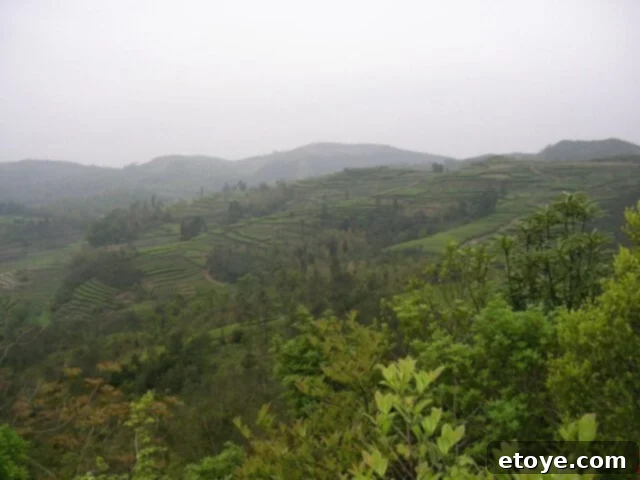
Tea growing hills in Fujian, China
For many, tea is more than just a beverage; it’s a journey, a ritual, and an exploration of diverse cultures and flavors. My own journey into the world of tea began quite unexpectedly. Last year, my mother returned from a trip to China, bringing back packets of exquisite green tea. While I wasn’t a dedicated tea enthusiast at the time, these high-quality leaves quickly changed my perspective. What started as a casual post-dinner drink soon evolved into a cherished, relaxing ritual, offering a serene close to each day.
My appreciation for tea deepened further a few months ago when I had the pleasure of meeting Phil from Two Leaves and a Bud. His passion and the incredibly fragrant Asian teas he introduced me to were transformative. They effortlessly replaced my long-standing morning coffee routine, and soon, I found myself savoring various teas throughout the entire day. The sheer diversity of tea is what truly captivates me. Unlike coffee, where regional nuances exist, tea offers an unparalleled spectrum of flavors influenced by everything from the specific varietal of the plant, its region of origin, the harvest season, and the meticulous drying methods, to the artful blending processes. This intricate interplay of factors creates a complexity that rivals the world of fine wines, making each cup a unique discovery.
While coffee certainly boasts its own complexities, the distinctions in tea’s flavor profiles, derived from these myriad factors, are often far more pronounced and diverse. Take Earl Grey, for instance, a classic black tea infused with natural bergamot oil, which imparts a distinctly citrusy aroma, making it an ideal companion for a cozy, rainy morning. My personal favorite, Gen Mai Cha, is a Japanese green tea blended with toasted brown rice puffs, offering a delightful nutty and roasted flavor that I adore in the afternoon. And for a perfect after-dinner treat, I often reach for Indian Chai, with its rich, full-bodied black tea base infused with an aromatic blend of warming spices—a truly indulgent choice that serves as my liquid dessert.
To help you embark on your own tea journey, I’ve invited Phil to share his expertise in an article about the fascinating “Art of Tea Tasting.” He introduces a flavor wheel, a tool originally used in wine tasting, which vividly illustrates how the language and nuances of tea flavors remarkably parallel those of wine. Prepare to open your senses and discover a whole new world in your cup!
~Jaden

Mastering the Art of Tea Tasting: A Connoisseur’s Guide
By Phil Edelstein, Two Leaves and a Bud
For countless individuals worldwide, a cup of tea is a daily ritual, a comforting presence in our lives. Yet, how often do we truly pause to explore the intricate symphony of aromas that greet our nose or the nuanced flavors that dance upon our palate? The world of high-quality tea offers a complexity of flavor that can easily rival the most robust and sophisticated wines. Unraveling the incredible variety of tastes, textures, and aromas hidden within your favorite teas is not just an enriching experience, but a delightful adventure that connects you to tea gardens spanning the globe.
The prospect of formally tasting tea and finding the precise language to describe its intricate character can initially seem daunting. Expert tea tasters, hailing from prestigious tea gardens across the world, may evaluate thousands of cups annually. Here at Two Leaves and a Bud Tea Company, our commitment to quality means we’re constantly assessing different “crops” of tea on a weekly basis, meticulously noting the subtle differences in cup color, aromatic profiles, mouthfeel, and distinct flavor notes. This rigorous process ensures we select only the finest leaves for our customers.
So, where does the average “cuppa-a-day” tea drinker begin this journey of discovery? Fear not! This comprehensive, step-by-step guide to the art of tea tasting is designed to transform you from a casual drinker into a confident connoisseur in no time. Let’s embark on this aromatic adventure together!

Essential Preparation for an Optimal Tea Tasting Experience
The foundation of any successful tea tasting lies in meticulous preparation. Properly brewing the tea you are about to evaluate is paramount, as it directly impacts the flavors and aromas that will be revealed. Interestingly, the preparation for a formal tea tasting often diverges significantly from your everyday home brewing methods. Here’s how to set the stage for an insightful tasting session:
Selecting Your Tea and Water Ratio
For a standard serving, an average tea sachet or a typical amount of loose leaf tea generally contains around 2.8 grams of tea, steeped in approximately 350 mL of water. However, for a formal tea tasting, we aim to intensify the tea’s profile to better discern its inherent characteristics. To achieve this, you’ll want to either double the amount of tea leaves you would typically use (around 5.6 grams) or, more conveniently, halve the amount of water to 175 mL. This concentrated brew, though perhaps not ideal for casual sipping, is crucial for “overemphasizing” the subtle flavors and aromas that might otherwise go unnoticed, making them more apparent to your palate. Consider using dedicated tasting cups, often white porcelain, to allow for clear observation of the liquor’s color.

Mastering Water Temperature
Heating your water to the correct temperature is a critical step that cannot be overstated. Different tea types require specific temperature ranges to extract their optimal flavor without imparting bitterness or dullness. Understanding these nuances is key to a rewarding tasting experience:
- White and Green Teas: These delicate leaves are highly sensitive to heat. Too high a temperature will “scorch” them, resulting in a bitter, astringent, or burnt flavor. Steep these teas at a temperature range of 170 to 185 degrees Fahrenheit (77-85°C).
- Oolong Teas: Occupying a middle ground between green and black teas, oolongs require slightly more heat than greens. Brew them at temperatures between 180 and 190 degrees Fahrenheit (82-88°C) to coax out their complex floral, fruity, or toasty notes.
- Black and Herbal Teas: These heartier leaves are much more forgiving and benefit from higher temperatures to fully release their robust flavors. Steep black and most herbal teas at a near-boiling temperature, typically between 208 and 212 degrees Fahrenheit (98-100°C).
Using a temperature-controlled kettle or a thermometer is highly recommended for precise results.
The Perfect Steep: Time is of the Essence
Once your water reaches the ideal temperature, pour it over the measured tea leaves. Cover your mug or teapot immediately to preserve the heat, ensuring a consistent steeping environment. For tasting purposes, a longer steep is generally employed to fully extract all flavor compounds. Set a timer for 4-5 minutes – this full-fledged steep, especially with the concentrated tea-to-water ratio, ensures that every nuanced flavor component is drawn out. Promptly remove the tea leaves after the timer goes off to prevent over-extraction and excessive bitterness.
With these careful preparations complete, you are now perfectly poised to begin the fascinating journey of tea tasting!
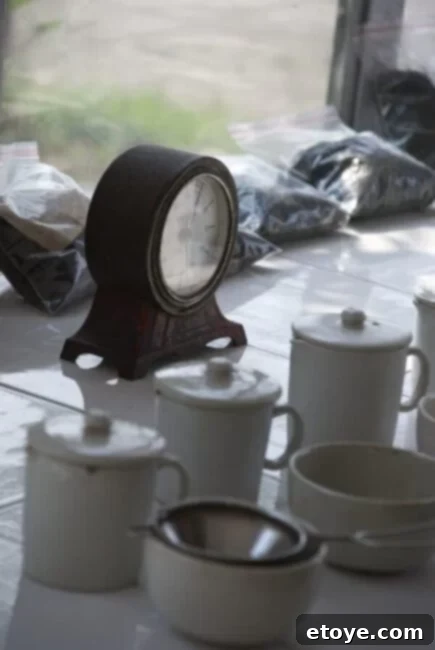
The Art of Engaging Your Senses: Techniques for Tea Tasting
You might still be pondering why we advocate for steeping double the usual amount of tea or using half the water. The rationale is simple yet profound: this method deliberately “overemphasizes” the hidden flavors within each tea. While such a concentrated brew might not be your everyday preference, it serves as a powerful tool to tease out and amplify subtle nuances that you might normally overlook, making them unmistakably apparent to your tongue and nose. Beyond this preparatory step, several techniques during the actual tasting process will significantly enhance your ability to perceive and identify the intricate flavors of tea.
Visual Inspection: The First Impression
Before even taking a sip, observe your tea. Note the color of the dry leaves – are they bright green, dark twisted, or a blend? After steeping, examine the “liquor,” or brewed tea. Is its color clear, bright, dull, or cloudy? Does it possess a golden hue, a rich amber, a vibrant green, or a deep mahogany? These visual cues can often provide the first hint about the tea’s character and processing.
The Olfactory Experience: Smell Before You Sip
Scientific studies consistently show that 80-90% of what we perceive as taste is, in fact, due to our sense of smell. With this in mind, approach your cup of tea much like a sommelier would a glass of wine: bring the tea slowly to your nose, taking a deep, long inhale. Allow the complex aromas to fill your nasal passages. What do you detect? Floral notes, earthy undertones, malty richness, or perhaps a hint of fruit? This initial aromatic assessment is crucial, as it primes your brain for the flavors you are about to encounter on your tongue.
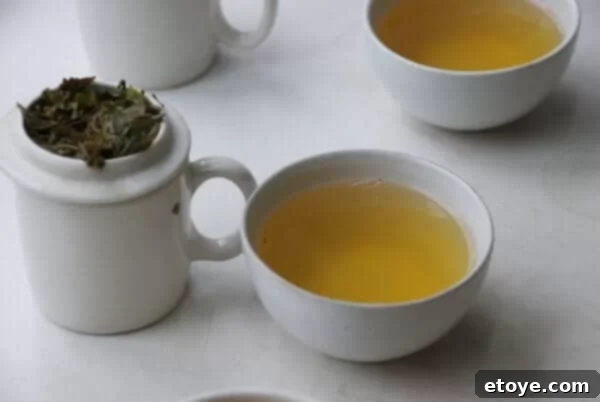
The Artful Slurp: Aeration for Flavor Enhancement
Yes, it might seem a bit impolite or noisy in a formal setting, but “slurping” your tea is, unequivocally, the most effective way to truly taste it. This technique serves multiple purposes: it cools the tea to an optimal tasting temperature, and more importantly, it aerates the liquid. As you slurp, the tea is drawn across your entire palate, ensuring it touches every taste receptor on your tongue. But don’t swallow just yet! Hold the tea in your mouth and, with your lips slightly parted, gently draw in a little more air (cue more soft slurping sounds). This further aerates the tea, allowing its volatile aromatic compounds to reach your olfactory receptors from the back of your throat, bringing out the full, complex range of flavors and enriching your overall perception.
Mouthfeel: The Unseen Texture
Beyond taste and smell, pay attention to the tactile sensations the tea creates in your mouth. Is it smooth and buttery, or does it have a brisk, almost drying sensation (astringency)? Does it feel light-bodied or full-bodied? These elements of “mouthfeel” contribute significantly to the overall character of the tea and vary greatly between different types.
The Optional Spit: A Taster’s Choice
Now, your tea tasting journey might get truly unconventional! Just like in professional wine tastings, spitting out the tea after you’ve thoroughly evaluated it is an optional practice. Many experienced tea tasters choose to spit to avoid becoming overly “jived” or hyper-stimulated by the caffeine content, especially when sampling numerous teas in a single session. For personal tastings at home, however, you might prefer to simply savor and swallow.
Palette Cleansing Between Teas?
An interesting point often arises: do you need to cleanse your palate when tasting multiple teas? Surprisingly, you generally do not. Unlike wine tasting, where neutral crackers or water are often used, experienced tea tasters typically transition from one tea to the next without an intervening pause. The unique flavor profiles of different teas rarely “dilute” or significantly interfere with the perception of the subsequent tea. This allows for direct and rapid comparison of their distinct characteristics.
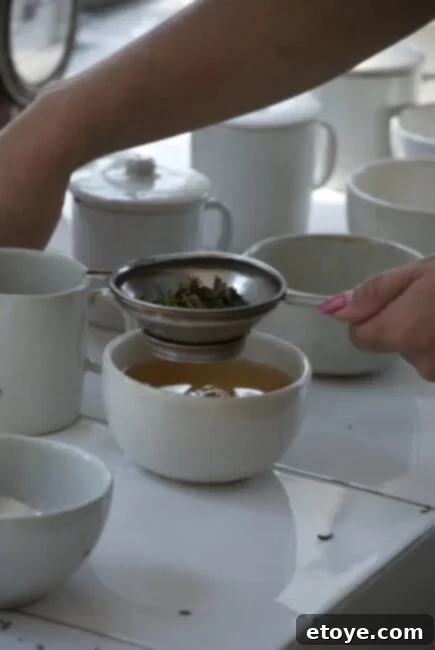
Deciphering the Brew: Describing Your Tea Tasting Experience
Now comes perhaps the most challenging, yet rewarding, aspect of tea tasting: translating what your senses have perceived into articulate language. It’s important to remember that this step is inherently subjective – there is no single “right” answer. Your personal experience and the adjectives you choose to describe your tea are perfectly valid and unique to you.
To assist in building your descriptive vocabulary, especially when you’re just starting, let’s explore a valuable tool: the flavor wheel. This concept, often borrowed from wine tasting (courtesy of My Wine World), provides an excellent starting point for standardizing and expanding your tea descriptions:
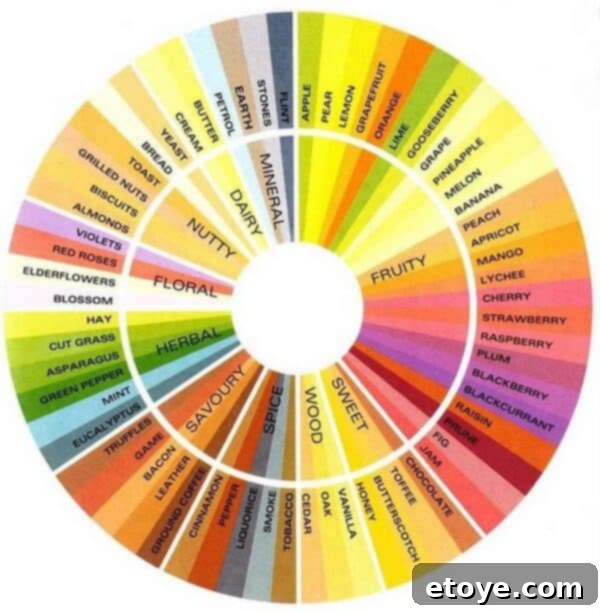
As you can observe, this flavor wheel offers a rich array of suggestive terms, categorized to help you articulate the nuances of your tea. It moves from broad categories (like “Floral” or “Fruity”) to more specific descriptors (such as “Rose” or “Cherry”). When describing your tea, try to identify a primary category, then delve deeper into more specific notes. For example, if you taste “Fruity,” is it more like “Dried Fruit” or “Citrus”?
If you’re still seeking inspiration or a more structured approach, let’s delve deeper by examining general flavor profiles associated with different types of tea, categorizing them into the broader flavor categories (such as woody, sweet, fruity, etc.) where they typically reside.
Black Teas: Robust and Varied
Black teas, which are fully oxidized, are renowned for their strength and often malty or robust characteristics. Their earthy, deep tones frequently align with the “Wood” and “Mineral” categories on the flavor wheel. Common descriptors include malty (like Assam), fruity (like Darjeeling, with muscatel notes), sweet, honey, cocoa, tobacco, or even smoky (like Lapsang Souchong). They can also exhibit a briskness or a smooth, full-bodied mouthfeel.
Green Teas: Fresh and Vegetal
Green teas, minimally oxidized, are celebrated for their freshness and often vibrant, “green” taste profile. Their predominant vegetal and sometimes oceanic notes mean they generally fall under the “Herbal” or “Vegetal” sections of the flavor spectrum. Expect descriptors such as grassy, spinach, seaweed (especially Japanese greens), nutty (like some Chinese greens), sweet pea, floral, or even a subtle bitterness that can be pleasant when balanced.
Oolong Teas: The Spectrum of Complexity
Oolong teas represent a fascinating spectrum, as their oxidation levels can vary widely, placing them between green and black teas. This makes their flavor profile incredibly diverse. An oolong’s taste can be smoky and/or sweet, green and/or black, floral, or fruity. Consequently, they often bridge multiple categories, embracing “Spice,” “Sweet,” “Wood,” and “Floral” notes. Common descriptors include roasted, buttery, honey, peach, orchid, nutty, or even a creamy texture (like Milk Oolong).
White Teas: Delicate and Subtle
White teas are the least processed of all tea types, known for their incredible subtlety and delicate flavor. They are typically light, bright, and often possess a natural sweetness. You’ll frequently encounter pleasant “Floral” aspects in white tea, alongside gentle notes from the “Sweet” realm of the spectrum. Descriptors like honeydew, apricot, fresh hay, or faint floral aromas are common, paired with a remarkably smooth and often velvety mouthfeel.
Flavored and Herbal Teas: Blended Delights
The tea profiles above describe the intrinsic flavor of the tea leaf itself. But what if you’re sipping a Jasmine Petal green tea or a complex herbal blend like our Organic Better Belly Blend, which features eleven different herbs? The approach is straightforward: look to the ingredients! For our Jasmine Petal green tea, combine the characteristic descriptors of green tea with the fragrant notes of jasmine petals, drawing from the “Floral” or “Sweet” categories. If you’re enjoying our Organic Mountain High Chai Black Tea, which is infused with spices like cinnamon, cardamom, and clove, integrate the robust descriptors of black tea with evocative terms from the “Spice” category, such as warm, pungent, or aromatic. This layered approach allows for a comprehensive description of the entire sensory experience.
The Journey of Experience: Cultivating Your Palate
Your initial foray into formal tea tasting might not yield perfect results. You might not instantly find the precise words to articulate every nuance after your first slurp. But the key is perseverance! Experience, above all else, makes a profound difference. As you consistently refine your palate and train your brain to consciously identify and describe what it’s tasting, the right words and sensory connections will become increasingly accessible and intuitive.
Most importantly, throughout this ongoing journey, you’ll cultivate a deeper, more profound appreciation for every cup of tea you taste. This heightened awareness will empower you to genuinely differentiate between an average, run-of-the-mill brew and some of the truly extraordinary teas the earth has to offer, transforming each sip into a moment of pure discovery and delight.
Global Tea Landscapes: Photos from Our Journeys
Here are some captivating photos from Two Leaves and a Bud’s recent sourcing trips to the vibrant tea-growing regions of China, Japan, and India.
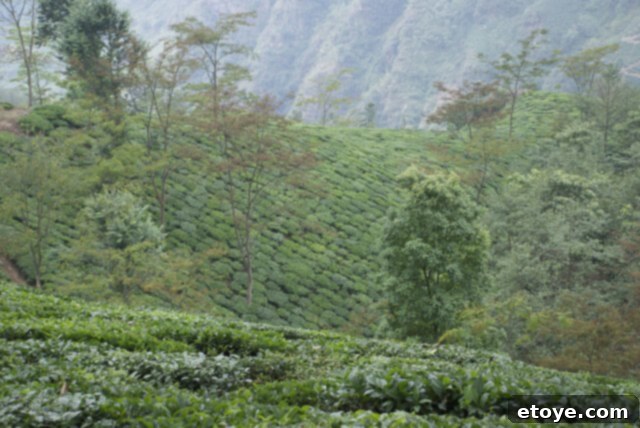
Tea Hillside – Tea bushes growing on the hilly landscape of Darjeeling, India.

Irrigation – looking down the slope of one of Darjeeling’s many hills.

A tea plucker about to make her way out to pluck tea in Assam, India.

A view of Darjeelingtown, India.

Pluckers harvesting tea in Darjeeling, India.
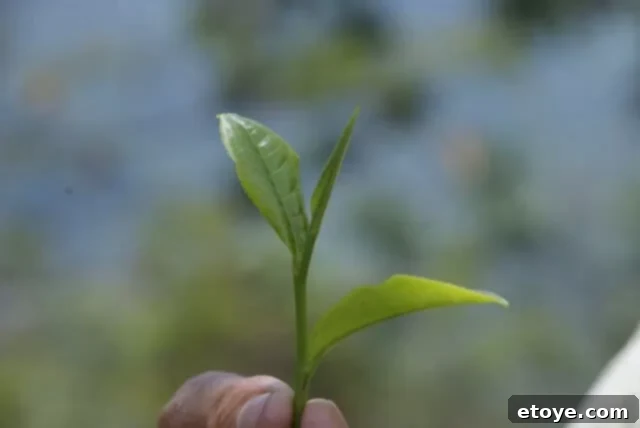
The actual “two leaves and a bud” of the tea plant, plucked in Assam, India.

A view of the green tea fields in Fujian Province, China.

Freshly plucked green tea.
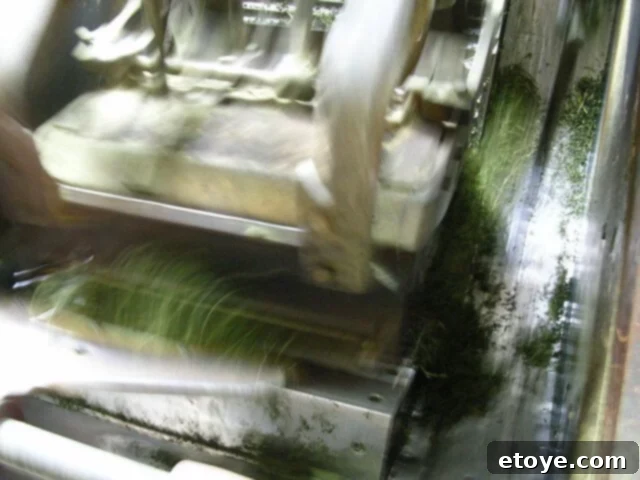
A green tea “CTC Machine” which takes whole leaves of tea and cuts, tears and curls them so that they can fit in a traditional teabag.

Green tea being steamed in the traditional Japanese style.

Colorful saris wait in line in India.

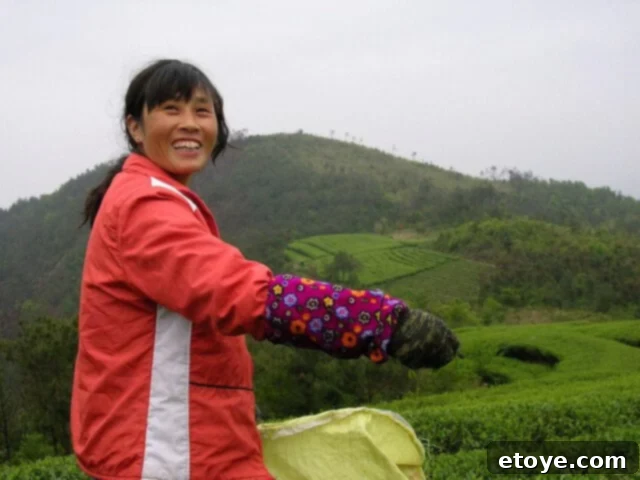
A plucker happily picking tea in Fujian Province, China.

Pluckers dot the hillsides in Darjeeling, India.